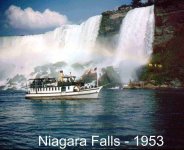I just finished a project restoring about 900 slides taken between 1946 and 1971. Due to their age, many of the original 35mm slides were badly faded and scratched. The following hardware & software was used in the restoration process:
<ul type="square">
[*]A Slide Scanner. It’s a special hardware device that is especially made for digitally scanning the slides into the computer. I purchased a PrimeFilm 1800u slide scanner (digitizes the original slides at 1800 dpi).
[*]Adobe Photoshop Elements 2.0 using these filters:
- Kodak Digital ROC version 1.1.3 (acquired separately as a plug-in) – This is the real magic necessary to restore faded slides !!!!
- Dust & Scratch (built-in filter)
- Quick-fix filters (built-in filter)
[*]Adobe Photoshop Album 2.0
[/list]
The following steps were used to scan and restore the slides:
<ul type="square">
[*]Each slide was individually scanned, which created the original “jpeg” image. The jpeg images were stored in directories that loosely describe when or where the slides were photographed. The files names also indicate the order in which with slides were scanned. It takes about 1 minute to scan each slide to produce apprx. a 5 meg jpeg (big).
[*]Using Photoshop Elements, a combination of filters was used to restore the jpeg images. In the majority of cases, Digital ROC provided the real magic by eliminating the red fading on most of the slides, followed by the quick-fix filters for brightness adjustment. The dust and scratch filter was used sparingly to cleanup really dirty or scratched slides.
[*]Using Photoshop Album, each slide was dated and any hand-writing on the slides was transcribed into the title field for each slide. In addition the slides were organized into meaningful categories. As information, Photoshop Album’s title and date information gets embedded inside the jpeg image as meta-data. Only jpeg specific programs know how to access this information.
[*]For presentation purposes, some of the better slides were titled by embedding a large-font title directly into the jpeg file (as a single layer). The titled jpegs were saved separately with an “_edited” suffix. The original (restored) jpeg files were also preserved as the embedded titles cannot be removed.
[*]Multi-page PDF’s were created to support easy presentation and viewing.
[/list]
I'm very very happy with the results. It was a fairly significant effort, but well worth it to preserve family history. The total investment in hardware & software was approx. $400. Given the poor condition of my slides, I'm not convinced that a slide restoration service could have done a very good job.
See the attached slide as an example. It's a bit grainy because I had to scale back the original 5 meg jpeg back to a 100k version to post on TBN. Not bad for a 50 year old slide!

